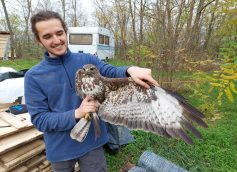heading
Today, in any field of science, we can observe interdisciplinary directions, which are born from the fusion of related disciplines. By combining scientific fields and at the same time comparing the methods of different fields, we can get answers to new questions that go beyond a single subject. Understanding the niche model of ecology gives a new dimension to the complex study of the composition of living communities. The habitat of each population is determined by biotic and abiotic factors. The examination of biotic variables is the task of ecology, while abiotic variables cannot be examined with ecological methods, as the scales often used for their evaluation are too robust for detailed analyses. The measurements carried out by hydrologists and hydraulic engineers can provide a much more accurate description of these abiotic variables, so by combining the two, we can discover new relationships. In this study, we assigned the data of the 20 most common fish species in the Hungarian section of the Danube River from 2004 to 2022 to the data of hydrological datasets and hydrodynamic simulation models, and looked for patterns among them using Machine Learning (ML). Among the nine abiotic factors used as independent variables in the analysis, the average depth velocity, water depth and bed material composition were the most decisive variables, which aligns with the results of previous research. In addition, with our Random Forest model, we were able to predict the number of individuals of the 20 most common fish species in the given conditions in the entire Hungarian section of the Danube. These estimates refer to optimal habitat for fish species according to abiotic variables. The model gives accurate values only in a narrow range, the so-called hydromorphological optimum, where our variables determine the abundance of fish. The results of the studies showed that in most cases biotic factors are more dominant than abiotic variables. In addition to the ML analysis, we showed the possibility of using the Danube fish faunistic database, which covers a large area and time, to investigate the relationships of the population (for example, the relationship between invasive and native species) using classical statistical methods. The results found here are in many cases consistent with the Random Forest model, but give reason to extend the model with additional independent variables in order to better understand the ecology of the Danube fish species.
This is how I came up with the idea for this project:To find solutions to problems and keep up with change, we need to understand how wetland ecosystems work!

Documentation
Relations between composition of fishes and hydromorphological variables in a very large river In this study, we assigned the data of the 20 most common fish species in the Hungarian section of the Danube River from 2004 to 2022 to the data of nine abiotic parameters, and looked for patterns among them using ML. Among the abiotic factors used as independent variables in the analysis, the average depth velocity, water depth and bed material composition were the most decisive variables, which aligns with the results of previous research. In addition, with our RF model, we can predict the suitable habitats of each fish species under given conditions and examining the impacts of biotic factors. Our methods can be transplanted to other large rivers, to investigating the ecology of fishes.
